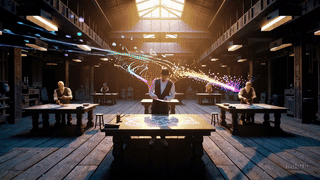
From Theory to Practice
The Expansive Agents methodology established a new paradigm for agent development. Now we turn to the practical implementation: Agent Storytelling.
The Command-to-Execution Interface
Agent Storytelling unlocks encapsulated intelligence that responds to natural business commands:
“Get my top opportunities from Dynamics and then send through email as a draft addressed to my team.”
A statement of intent becomes executable workflow. No technical knowledge required. No development cycle. No translation layer.
This is not theoretical. This is immediate action.
The Agent Stage
The Agent Stage provides the visual representation of this encapsulation. Agents populate the stage based on natural language commands. Connections form automatically. The business narrative appears visually.
What happens when a command includes functionality not yet implemented? The system documents the need, generates the technical specifications, and routes to development teams – all automatically. Business needs documented in real-time, not through lengthy requirements processes.
Demand-Driven Development
Traditional development depends on explicit requirements. Agent Storytelling captures organic business needs through natural conversation. The aggregate of these commands forms a heat map of business demand, highlighting the highest-value development priorities.
The IT prioritization process transforms from executive mandate to user-driven selection. Resources flow to capabilities with demonstrated demand.
The Power of Encapsulated Intelligence
Agent Storytelling works because it encapsulates complex intelligence operations into simple, domain-specific agents that communicate seamlessly:
“Analyze the feedback from our customer support tickets and prepare a summary of recurring issues.”
Behind this simple command:
- Document processing agents extract meaning from unstructured text
- Classification agents identify patterns across feedback
- Analysis agents determine significance and frequency
- Communication agents craft clear summaries
The complexity remains hidden. The results emerge immediately.
Real-Time Business Intelligence
Consider the transformative impact:
“Compare our team’s sales performance to the same period last year and visualize the trends by product category.”
This command, issued by any business user:
- Retrieves relevant data from enterprise systems
- Performs appropriate comparative analysis
- Generates meaningful visualizations
- Delivers actionable insights
What once required specialized business intelligence teams now happens at the speed of conversation.
The End of Wait States
Business suffers from endemic wait states:
- Waiting for development resources
- Waiting for technical implementation
- Waiting for integration testing
- Waiting for deployment windows
Agent Storytelling eliminates these delays through immediate execution when possible, and accelerated development when necessary.
The Shift in Development Focus
For development teams, this represents liberation. Energy shifts from building basic functionality to enhancing agent capabilities. Technical expertise applies to extending what agents can do, not recreating what they already do.
The Enterprise Knowledge Network Evolved
The Enterprise Knowledge Network concept now becomes executable through simple commands:
“Create a network that connects our product documentation, customer feedback, and support tickets so anyone can ask questions and get accurate answers.”
This single command initiates an agent cluster that crosses traditional system boundaries, establishing connections that were previously impossible or required months of integration work.
From Imagination to Implementation

With Agent Storytelling, the distinction between imagining a solution and implementing it dissolves. Business users speak their needs. Agents execute. Technology finally delivers on its ultimate promise: moving at the speed of ideas.
The revolution continues.
Kody Wildfeuer is an AI architect exploring the potential of agent-based development methodologies. The views and opinions expressed throughout this blog are his own and do not necessarily reflect the official policy or position of his employer.











